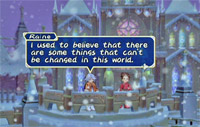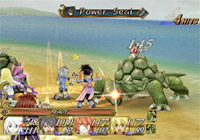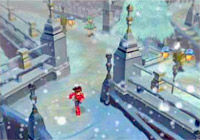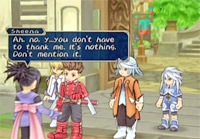




 | 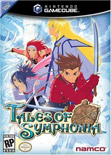 |
| |||||
|
|
It's true that the GameCube doesn't have a lot of depth to its exclusive RPG offering. Actually, I don't think I could name more than two or three console-exclusive role players for Nintendo's current gen cosole. Interestingly enough, that number seems to be dropping, rather than growing, as more Cube-exclusive titles are brought to Sony or Microsoft's consoles, while less wholly original games seem to be in the works for the system going forward. Such was the case with Tales of Symphonia; originally brought over as a Gamecube exclusive, it was eventually ported over to the PlayStation 2 after gathering some mild critical praise and very little real visibility. Sadly, the title's notoriety didn't exactly explode upon arriving on Sony's RPG-heavy system, either, and it's since been left in the dust as the focus has turned to a follow-up, Tales of Legendia, recently released exclusively on the PS2. I didn't realize it when I made my purchase, but Namco's Symphonia is only the latest chapter in an ongoing series of RPGs, featured on both the Super NES (Tales of Phantasia... noticing a trend?) and the Gamecube, as well as a fair share of the consoles released in between. In the vein of Final Fantasy, none of the chapters seem to have anything to do with one another and are related via name and battle system only. Tales is more widely recognized overseas, where the vast majority of the series was exclusively released (of the dozen games in the run, only two were brought to America prior to Symphonia) and that's really a shame, as it seems many US-released Action RPGs have adapted (and been subsequently praised for) more than a few elements from the Tales style of gameplay. The battle system, for instance, is eerily similar to the one I fell in love with in Star Ocean: The Second Story, and I'm not really sure which series, if either, brought that particular style of battle to the table first. My first experience was with Star Ocean, though, and even if my way of thinking is flawed for feeling so, I can't help but immediately recognize that game as the originator and Symphonia as the imitator. I wasn't blown away by my first few hours with Symphonia's battles like I was with Star Ocean's, because the concept wasn't totally new to me any more, regardless of how just or unjust that might be. It's really a case of withholding innovation from the English-speaking audience for too long... if the games in the Tales franchise had washed up on our shores about ten years earlier, it's entirely possible they'd be up there among the elite of the genre from my perspective. But despite that excessively lengthy back story and my apparent claims of ignorance, I had read a few good things about this one before I chose to pick it up. I'm not sure where, exactly, I'd read that it was "the GameCube's best RPG" (which admittedly isn't all that impressive a feat, considering the aforementioned lack of releases in that specific category) but those words must have had some kind of an effect on me, as it wasn't long before I found it as a part of Nintendo's "greatest hits" line and added it to my collection. I'd been itching for a good RPG for a few months, and despite the calls of Dragon Quest VIII from my media shelf, this one got the nod. A few hours of rambling, shiny-happy dialog later, and I wasn't entirely sure I'd made the right decision. As an extensive, multiple disc-spanning role player, I'd assumed that the story would have been the one surefire area that wouldn't let me down, and that assumption was pretty much dead wrong. The quick summary is that you'll play the role of Lloyd Irving, a teenaged boy with a cloudy past, who stumbles (along with several friends, naturally) into the adventure of a lifetime, culminating in the rescue of not one, but two endangered worlds. It seems that Lloyd's lifelong friend, Colette, is at the center of a once-every-generation pilgrimage that leads to the mysterious salvation of the world, and that everyone but Lloyd realizes that this journey will not end well for Colette. Basically, it's the plot of Final Fantasy X with more of a homogenized, Saturday morning cartoon flair, and less hideous flying monsters named "Sin." I had a really hard time enjoying the progression of the story, as not only was the writing a bit suspect and the characters largely unlikable, but the pacing was jerky and off-putting. After a handful of hours of treading water and building toward an ongoing climax, just as things would begin to get interesting, the story would slam on the brakes and go right back to treading water again. If the writing was feeling particularly exotic, maybe you'd gain or lose a party member in the process. Almost without fail, every single time you'd be riding a wave of adrenaline after completing a dungeon or ready to kick some bad guy ass after a sour betrayal, rather than taking advantage of its own momentum, the storyline would stagnate and deliver some sort of eye candy or lame change of scenery. After dealing with this the first couple of times, I found myself soured to the potential of the storyline for the remainder of my experience. Perhaps most accountable for the slow death of the story was the inclusion of far, far too much unnecessary dialog, without any sort of payoff to validate its existence. This is a game that would have benefitted tremendously had it been basically halved in length. The plot isn't without its intricacies and shining moments, but they're so few and far between that they lose a lot of their impact amid the tedious, back and forth discussions and repeatedly dull, fetch-and-return styled missions. Conversations almost always go on well beyond the point of good reason, even in key situations. It's understandable to have a silly, one-sided conversation with an unimportant character on the outskirts of a city somewhere... such dialog is the bread and butter of RPGs as a whole. Where such meanderings are less acceptable and more damaging, however, are in the key scenes after crucial battles or big plot twists. About two thirds of the conversations in Symphonia are delivered via written text, while the more important chats are spoken by a cast of voice actors... it's a fairly good way to indicate to the player that they need to pay special attention to what's going on, because what's being discussed is going to affect the way the game plays out from that point forward. Yet even these spoken scenes are usually marred by poor writing and unnecessary asides that only serve to elongate the experience. I had to laugh when, after defeating an important mini-boss around the midway point of the game, one of my characters went back and forth with that boss in an argument that sounded like something straight out of the playgrounds of an elementary school at recess. It wasn't a discussion or even an argument, so much as it was two characters shouting "no, you're wrong" back and forth at each other for what seemed like an eternity. And, while that example is a little more extreme than most instances, the fact remains that empty, meaningless conversations dominate way too much of this game. RPGs earn a little more leeway than other genres in that lengthy monologues and lots of reading are to be expected, but Symphonia takes advantage of that situation and crams the screen full of stuff that really should've been left on the cutting room floor. I spent fifty two hours shoveling through about twenty hours' worth of really interesting material. The characters likely suffer from this, as the monologues get in the way of what could have been good characterization time. That's not to say Symphonia is completely devoid of character development, as every time I seemed ready to throw up the white flag and completely write the story off, it would come through with a solid bit of interaction between the members of your party. For the most part, though, your comrades are treated like a collection of inflatable love dolls... there to be used if their specific talents and traits should be necessary, and then cast aside and forgotten as soon as their usefulness is exhausted. What individual development there is seems like an afterthought and is generally very transparent and flat. Raine, for instance, has a deathly fear of water which surfaces from time to time, but isn't handled with any kind of subtlety. Rather than trying to hide her insecurities or make excuses for herself, she'll basically come right out and say "Ohh, I don't like water..." and that'll be the end of it. Lloyd will still force her to cram herself into a tiny boat and send her off across the ocean, and she arrives no worse for wear on the other side, as if the whole episode had never happened. Their hearts were in the right place, I suppose, but the execution is just terrible. Finally, I found the almost complete lack of self-direction the storyline offers to be totally aggravating. While you'll find yourself faced with "yes or no" decisions from time to time, your answer never really factors into the direction of the storyline in any way. Even if you specifically choose not to do something, Lloyd will usually opt to sleep on the question and then awaken the next day to announce that he's decided to do it anyway. Comparably bothersome is the way the storyline chooses to force your characters into inactivity when something preventable is occurring during a live-rendered cutscene. For example, Colette is kidnapped on more than one occasion as the storyline slowly lurches along, and almost every single time she's just grabbed by a bad guy, as Lloyd and company stare on awkwardly, then whisked away to the tune of their protests. Even more entertaining is the repeated occurrence of easily defeating a cluster of enemies, then watching as your team screams "We're outmatched! Run!" and sprints away, as the very same creatures give chase. It doesn't make any sense, it's never really explored, nor explained... I think the story would just prefer you ignore the glaring holes in what's going on and pretend it'll all be answered in the end. Which, of course, it isn't. Assuming you can look past the majority of the story, however, the actual practice of playing the game (beyond pressing "A" relentlessly during the speaking portions) is an extremely enjoyable ride, with plenty of innovation to go alongside the more universally applied elements. All fights occur in real-time, and more resemble a limited Final Fight-style beat-em-up than a standard, turn-based RPG. You're limited to four party members in the field at one time, and will be routinely facing off with as many as six enemies at once. At first glance, the system looks to be nothing more than button mashing and a little luck, but as you become more familiar with your special attacks, working in conjunction with your teammates and shifting your strategy to fit each battle, the actual depth and flexibility of the system becomes much more evident. To tell the truth, I was far from a fan of this battle system until roughly the ten hour mark, when that tiny switch flicked in the back of my brain and I finally understood the intricacies of a fight in the world of Symphonia. The in-game instructions aren't exactly helpful in explaining the full potential of its own mechanics, which leaves you to sort things out on your own... and actually, I preferred it that way. It's much more rewarding when you develop a particularly successful strategy and apply it than it would have been, had you merely followed instructions and begun to paint by number. There is no such thing as a random encounter in Tales of Symphonia. When exploring a dungeon, you'll see a variety of independently moving critters roaming around the map, and upon touching them you'll be launched into a full-on battle. Out on the world map, roaming from one town or dungeon to the next, the enemies are a bit more faceless, and really resemble the little silhouetted monsters that populated the overworld of The Legend of Zelda 2: The Adventure of Link. I'd imagine this was to give each dungeon a personality of its own, and to keep you guessing as to what you'll encounter in the wild. There are, basically, two types of very easy-to-identify characters for use in a battle scene: magicians and melee fighters. Casting a spell during a battle in Tales of Symphonia isn't as easy as it is in other RPGs and is in actuality quite a bit more strategic. Magicians lose their concentration very easily, and must stand completely still for a set amount of time while they cast for the spell to be successful. If an enemy strikes them or they move to block a foe's assault, they've got to start the casting over from the beginning. Your melee fighters are fairly run-of-the-mill. They can attack with a basic attack or a special attack, which usually consists of a lengthy string of automated physical attacks, followed by a special "cherry on top" flashy final strike. These special attacks function almost exactly like a magician's spell, in that they drain away at a character's "TP," (magic points) but don't require the lengthy period of casting that a magic spell usually necessitates. Naturally, some melee fighters can use limited magic and some magicians have somewhat notable physical attacks, but each character's designated strength is in one of those two narrow fields. Most enemies are, likewise, assigned to one of these two roles, and are suspect to the same kind of strengths and weaknesses... but the more difficult bosses usually straddle the line between the two. A good team will find a way to disrupt an enemy's spell before the casting is completed, while also keeping the opposition's melee fighters from striking its own magic-users. During a fight, you take direct control of only one member of your party. The rest of your crew is either casting a spell, using an item (both of which can be initiated through a well-organized battle menu that freezes time while you strategize) or following your loose instructions, which range from "all out physical assault" to "concentrate on healing allies" and are defined in the field menu before encountering an enemy. Of course, it's my belief that any battle system that involves A.I. controlled teammates is inherently flawed, as the computer routinely makes idiotic mistakes (such as dropping everything to run directly into a fiery explosion) and single-handedly changes the course of the battle in the wrong direction... however, Symphonia has introduced two options for those looking to avoid an all-A.I. attack of stupidity. Most likely to be utilized is the single-handed manual method, which allows players to individually direct their team members. This mode is probably the most proficient, but also results in epic, lengthy battles every single time you encounter an enemy. I found particular success with this setup, as I'd try to have two melee-centric team members and two magicians on the field, would instruct the magicians to cast a specific spell, allow the computer-controlled fighter to live and die by his own merit, do everything in my power to keep the enemy away from the magicians with the other swordsman until they could cast their spells, and then repeat. More intriguing, however, is the second option: four player multiplayer support. I can't speak to how well-done it was, since I'm not exactly overwhelmed with friends who want to gather around the TV for a six-hour marathon session with an RPG, but I've got to applaud the ingenuity all the same. I can imagine how much easier an experience it must be to merely ask your buddy to concentrate on healing, and then trust his ability to get out of the way, should an errant fireball come his way, but I didn't experience it myself and can't really comment. Role playing games aren't exactly the right genre for shared screen multiplayer, but any attempted solution to the plague of stupid computer-controlled teammates is a welcome change to these eyes. Once you manage to find a setup that works for your own needs, the game becomes quite a bit easier... too much so, actually. By the time they reach the later stages of this game, I'd assume almost everyone will have discovered a specific roster and strategy that all but assures them of victory, and the final bosses don't ramp up the difficulty quite enough to ensure a competitive fight. I disposed of the final series of bosses without even breaking a sweat, and felt a bit let down by the ease with which I completed things. If you're willing to go through another fifty hours of gameplay, there's a hard setting that unlocks once you finish the game for the first time, but that's a bit excessive for my tastes. I'll always have a problem with a game that features more than one secret sidequest boss that's exponentially more difficult than the final battle, and that's absolutely the case here. It feels like the game's priorities are in the wrong place, and drains a good part of the thrill that defeating a particularly difficult boss has traditionally provided, by basically telling you in no short words that you can take that final battle any time you want to. The controller setup works well with the way the battle system functions, and never gets in the way, even when things are at their most frenzied. Successfully using the GameCube's controller is usually just a matter of how effectively the "A" button is mapped, since it's basically the sole point of focus on the hardware, with every other button and even the analog stick playing a secondary role. Fortunately, Symphonia handles the button in question admirably. In a battle, it's your driving force, working in conjunction with the direction you happen to be pressing on the analog stick to begin one of your basic attacks. While enduring one of the game's lengthy speaking segments, it both increases the speed at which the text appears and acknowledges that you've finished reading that passage and are now physically and emotionally prepared to enjoy the next sentence fragment. It's basically the only button you absolutely, positively have to have. The rest of the buttons are laid out, declining in button size as they also decline in order of importance. The "B" button activates both your special attacks and your magic, depending on the type of character you're controlling. The "Y" button brings up whichever menu is appropriate for the time, the trigger buttons momentarily pause the action while you choose a primary target, and the tiny "Z" button initiates incidental conversations at seemingly random points around the map. Because if there's one thing this game needed, it was more incidental conversation. The "Z" button also initiates your party's "Combined Attack," which is indicated by a slowly-filling bar at the bottom of the screen during battle, and amounts to little more than a series of combined special maneuvers. One area in which the controls run into a snag is in the world map, where roaming around the land can quickly become a headache-inducing experience. The camera angles chosen for this view are typically an three quarter overhead perspective, following the player from behind and perhaps zoomed in just a little bit too close for comfort. Should the camera nudge anything above ground level, such as a cliff or small building, however, it'll shift to a godawful view, directly over your party. It'll also kindly zoom in beyond the point of any comprehension, so that you're basically seeing your lead character's scalp and a few feet in either direction around him. Naturally, this makes navigating the map extremely difficult, and usually requires some maneuvering to get back into something resembling a workable view. Inside dungeons and during battle, no such issues are evident. The visuals are one area in which this title really excels. Although most characters are rendered via cel shading, which is a technique I'm starting to see overused more and more, they never look forced or unnatural. Set against the beautiful, painterly appearance of the entirety of the game's backdrops and surrounding textures, the shading gives the impression of a big budget, animated motion picture. It's a truly lovely combination, and gives the title a style and look all its own. The character designs are provided by Kosuke Fukishima, well known for his work with the "Oh My Goddess!" and "You're Under Arrest" animated series, and is truly a shining point for the title. The world is filled with a unique visual flair, which is both represented and enhanced by the characters' appearances and their choice in clothing (aside from Lloyd himself, who wears a jacket that he may as well have lifted from Vash the Stampede of Trigun fame). The enemies are universally outstanding, and rarely fall to the RPG trend of merely recoloring a design and unleashing it as an entirely different villain. While I'd be fibbing if I said that it absolutely never happens, on the occasion that an enemy's physical characteristics are reused, enough license is taken with their appearance to justify the existence. Truly, in many instances, the newer enemy is even more visually intriguing than its predecessor. Almost every area of the game is bright, cheery and colorful, but it never really comes off as overly cheesy and childlike. Well, maybe that's a bit much... there are a few instances where I found myself wishing for a more subdued palette... but for the majority of the title, you'll be reveling in what's brought to the plate. My only real complaint lies with the notable lack of cutscenes during dramatic moments, and that's more a personal preference than anything else. From start to finish, there are three animated cutscenes in this title, and none run for longer than a minute and a half. That makes the giant shot of an animated cutscene right on the back of the case a bit misleading, and there were surely some moments that would have benefitted tremendously from a little additional visual flair. Instead, 99% of the game is live-rendered, and while this is an example of one of the GameCube's better looking titles, I really would've preferred to see a little bit more than cel shaded polygons after a big fight from time to time. The audio has its ups and its downs, honestly. Some of the voice acting is really top notch, such as the brooding, secretive speech of Kratos and the unintentionally snooty tone of Raine, but for every character with a quality voice, there exist two or three that are absolutely wretched. Most of the summon monsters have irritating voices, and the leading duo of Lloyd and Colette are so super-nice and cheery, I want to take after them with a rusty butcher knife and a bag of salt. Even more enraging is the decision to borrow the "post battle closing remark" from Star Ocean: The Second Story, which is probably one of the only problems I had with that game. Basically, after dispensing with your opposition, the character who delivered the killing blow chimes in with something cute and / or witty and the scene fades to black before returning you to the world map or dungeon... except, "cute" and "witty" are terms which don't seem to apply to the writing of this game. Such remarks wear thin extremely quickly, and only serve to increase my hatred for most of the voice acting. The music, as well, goes beyond the point of no return with the inspiration gathered from colorful nature of the graphics, and is almost entirely forgettable. If I weren't such a stickler for listening to every last moment of spoken dialog in a game, I'd have more than likely played this from start to finish with the television muted and my iPod providing the audio input. I really held a strong dislike for Symphonia for most of my first handful of hours with it, but eventually developed an inexplicable attachment to it. I knew that I didn't like anything about the story, but I still had a strange fixation with seeing everything though to the end... maybe it had something to do with a sudden grasp and understanding of the battle system, which I really fell in love with after a brief, frustrating period of discovery. Maybe I just wanted to see a definitive ending, so I knew I'd never have to endure another of those terrible lengthy conversations. I can't say for sure, but there's definitely something about the experience that changed after about a dozen hours. Regardless, if you're a GameCube owner and you're jonesin' for an RPG, this will fill your need adequately. The battle system is outstanding, if you've got the patience to figure it out via trial and error, and the visuals are worth a look or two, because they use the Cube's hardware fairly well. If you're also the owner of a PS2 and / or an Xbox, I've got to say there are far better titles out there in the genre. The story stinks, the characters need some serious work, and there is a LOT. OF. NEEDLESS. CONVERSATION. I'd call the entire package above average, but it's not really anything I'm going to recommend my friends go out of their way to try out. Overall Score: 7.0 |


